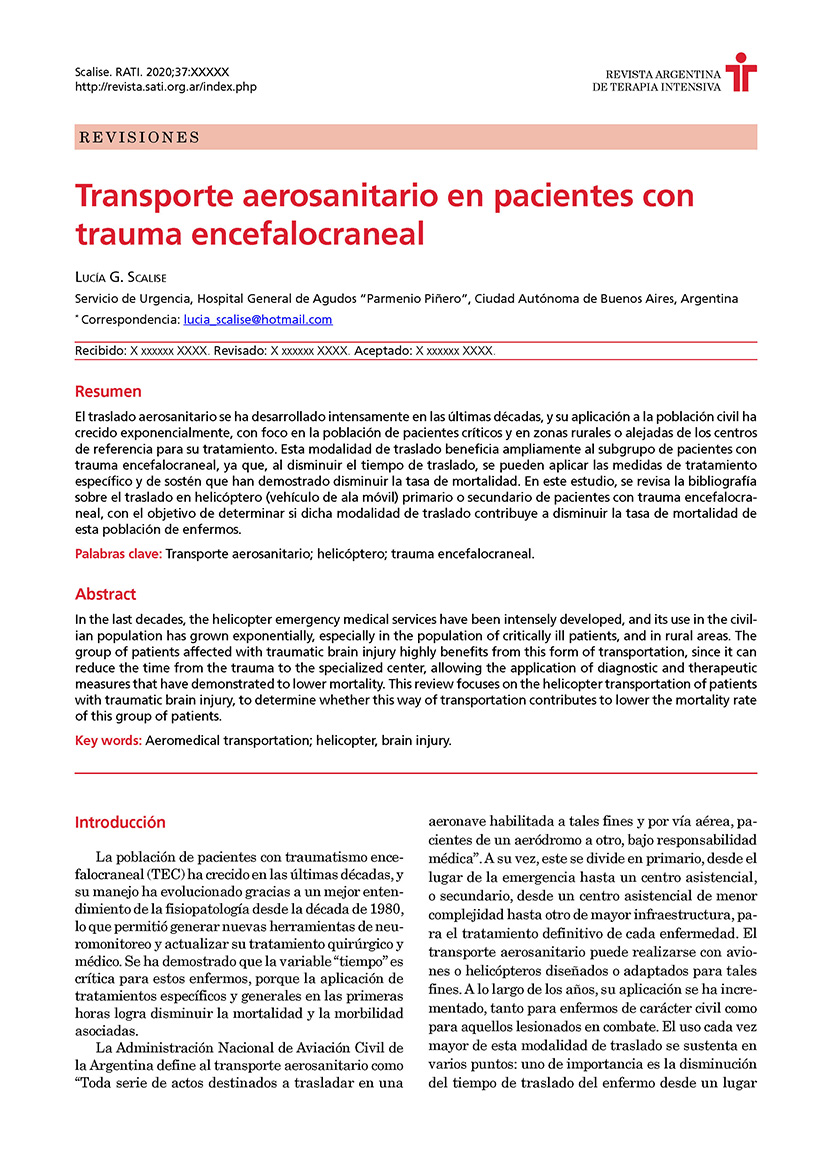Resumen
El traslado aerosanitario se ha desarrollado intensamente en las últimas décadas, y su aplicación a la población civil ha crecido exponencialmente, con foco en la población de pacientes críticos y en zonas rurales o alejadas de los centros de referencia para su tratamiento. Esta modalidad de traslado beneficia ampliamente al subgrupo de pacientes con trauma encefalocraneal, ya que, al disminuir el tiempo de traslado, se pueden aplicar las medidas de tratamiento específico y de sostén que han demostrado disminuir la tasa de mortalidad. En este estudio, se revisa la bibliografía sobre el traslado en helicóptero (vehículo de ala móvil) primario o secundario de pacientes con trauma encefalocraneal, con el objetivo de determinar si dicha modalidad de traslado contribuye a disminuir la tasa de mortalidad de esta población de enfermos.
esta población de enfermos.
Referencias
Chesnut RM, Marshall LF, Klauber MR, et al: The role of secondary brain injury in determining outcome from severe head injury. J Trauma 34:216-222, 1993 (II)
Sun H, Samra NS, Kalakoti P et al. Impact of Prehospital Transportation on Survival in Skiers and Snowboarders with Traumatic Brain Injury. World Neurosurg. 2017 Aug;104:909-918.
Bekelis K, Missios S, Mackenzie TA. Prehospital helicopter transport and survival of patients with traumatic brain injury. Ann Surg. 2015;261(3):579-85.
Davis DP, Peay J, Serrano JA, et al. The impact of aeromedical response to patients with moderate to severe traumatic brain injury. Ann Emerg Med. 2005;46:115–122
Di Bartolomeo S, Sanson G, Nardi G, et al. Effects of 2 patterns of prehospital care on the outcome of patients with severe head injury. Arch Surg. 2001;136:1293–1300.
Berlot G, La Fata C, Bacer B et al. Influence of prehospital treatment on the outcome of patients with severe blunt traumatic brain injury: a single-centre study. Eur J Emerg Med. 2009 Dec;16(6):312-7
Galvagno SM Jr, Sikorski R, Hirshon JM et al. Helicopter emergency medical services for adults with major trauma. Cochrane Database Syst Rev. 2015 Dec 15;(12)
Delgado MK, Staudenmayer KL, Wang NE, et al. Cost-effectiveness of helicopter versus ground emergency medical services for trauma scene transport in the United States. Ann Emerg Med. 2013;62:351–364.e19. Erratum in: Ann Emerg Med. 2014 Apr;63(4):411.
La revista no retiene los derechos de reproducción (copyright) por lo que los autores pueden volver a publicar sus trabajos con la sola mención a la fuente original de publicación.

